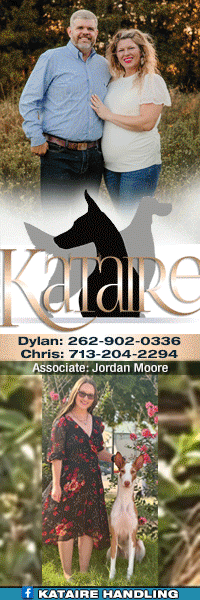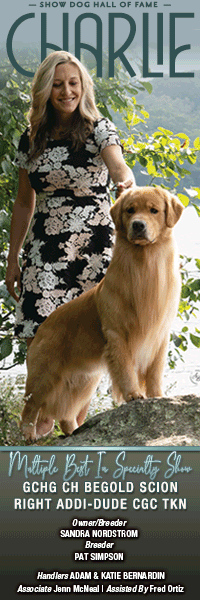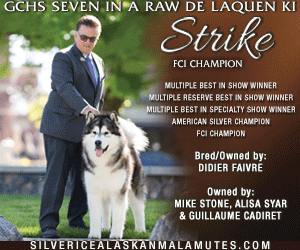A Family Rivalry – Madeline & James Austin
Madeline & James Austin
Click here to read the complete article
By Amy Fernandez
 Throughout the 1930s and ‘40s Madeleine and James Austin campaigned some of the era’s most legendary dogs under their respective Catawba and Wissaboo banners. Of course, many famous couples have reigned at the top of the dog game. Their substantial accomplishments are generally attributed to cooperative effort. The Austins revised that formula in one notable respect. When it came to that perennially cutthroat business of campaigning specials, they were definitely not teammates.
Throughout the 1930s and ‘40s Madeleine and James Austin campaigned some of the era’s most legendary dogs under their respective Catawba and Wissaboo banners. Of course, many famous couples have reigned at the top of the dog game. Their substantial accomplishments are generally attributed to cooperative effort. The Austins revised that formula in one notable respect. When it came to that perennially cutthroat business of campaigning specials, they were definitely not teammates.
It’s hard to overestimate the impact of their ongoing rivalry during an era when the Great Depression and World War II sent every level of the sport into a nosedive. Entries plunged, clubs disbanded, and crucial bloodlines died. In the midst of that, the Austins presented dogs that electrified audiences and made purebred history.
Foremost among them was Ch. Nornay Saddler. In addition to his impact on Smooth Fox Terrier development, Saddler also entered popular culture as a symbol American patriotism during WWII. Fairfax Downey ‘s History of Dogs for Defense detailed his surprising role. “The most successful fundraising device was the clever scheme proposed and put into operation by James. M. Austin and accepted by Dogs For Defense in January, 1943.” Realizing that most American owners wanted to support the newly established K9 Corps even though their pets didn’t qualify for military service, he devised the K9 home guard program that allowed owners to enlist their dogs and contribute to the war effort. “Owners could sign up their dogs in any branch of the armed services from Private or Seaman ($1) to General or Admiral ($100), even president Roosevelt enrolled Fala.”
The program’s popularity defied all expectations. “No small effort was required to stem the tide when DFD decided, in December 1944 that there were ample funds in the treasury.” That wasn’t Saddler’s only fundraising effort. The dog show grapevine buzzed when his unprecedented $50 stud fee was jacked up to $500 and all proceeds earmarked for the Army Relief Fund.
Episodes like this were business as usual for the Austins. They attracted publicity far beyond the dog world. Their lifestyle epitomized that time and place immortalized by F. Scott Fitzgerald in The Great Gatsby. Even AKC couldn’t conceal their fascination, as illustrated in this June 1940 Gazette reference to their sumptuous estate on Long Island’s gold coast, “You should see the Catwba-Wissaboo-Austins new house. It is just finished and looks very beautiful. Saddler’s trophy room looks like Gorhams in its heyday.”
In fact, it was substantially smaller than Madeline’s previous residence on the property. But it wasn’t modest by any standard, as noted in this eye-popping Brooklyn Eagle report March 6, 1942.
“Judge Thomas Trimble is pondering, among other things, whether the $30,000 a year spent by the granddaughter of the late Benjamin F. Jones, one of the founders of the Jones & Laughlin Steel Corp, to maintain a stable of racing horses, constitutes a living expense. Mrs. Austin, who resides in Old Westbury, contended that she was not able to live on the $60,000 yearly allowance (approximately $3 million today). After testifying that she employed 25 persons, 15 of whom cared for her horses and thoroughbred dogs, the petitioner itemized some of her annual living expenses as follows: Household $17,000, garage $6000, farm and garden $6000, stable budget $13000.” As suggested, Madeline was no amateur dabbler in the horse game. Among others, her stakes winners included Mr. Khayyam, the 1933 winner of both the American Derby and the Wood Memorial.
Madeline’s fortune came courtesy of her grandfather, Benjamin Franklin Jones. One of nine children, he left home at 18 to seek his fortune. Although it wasn’t apparent at the time, 1840s Pittsburgh was the place to be. He knocked around in production, shipping, and manufacturing, before staking a claim in the fledging iron and steel industry. Jones and his new partners pooled their collective expertise in banking, shipping, mining and metalworking to create Jones and Laughlin Steel Corporation. Almost overnight that ostensibly risky venture became a goldmine thanks to railroad expansion, mechanized agriculture, and the Civil War’s insatiable demand for munitions.
By then, every stage of J&L steel production was controlled by an impenetrable web of family-owned companies. That strategy yielded unimaginable profits long after the Sherman Anti-Trust Act began putting the brakes on the nineteenth century’s wild west of corporate monopolies. By the 1860s, when American annual salaries rarely approached $1000, Jones’s slice of J&L pie exceeded $325,000. Those dividends got bigger after Madeline’s uncle, B.F. Jones Jr., reorganized the company and took it public. He joined J&L in 1891. Madeline was born two years later, the third generation to experience the fruits of family success.
She grew up with every advantage of her social class and the means to pursue her interests in grand style. Nothing interested her more than Thoroughbreds and purebreds, especially Pekingese. Madeline was Mrs. Charles G. West Jr. raising four children when she established Madford Kennel and joined P.C.A in 1917. Despite those obligations, Madford quickly earned respect throughout the Peke world. That was just a warm-up for her subsequent achievements under the Catawba Farms banner.

It wasn’t the only kennel responsible for the influx of quality that redefined Pekingese type during the ‘30s and ‘40s, as historian George Davidson noted in his 1952 book. “In spite of curtailed operations, serious breeders improved the quality of their American breds by linebreeding and using these outstanding imports as outcrosses.” But Madeline certainly made a significant contribution with imports like Ch. Cherie of Huntington-Catawba, Eng./Am./Can. Ch. Liebling of Huntington-Catawba, Eng./Am. Ch. Wu Foo of Kingswere, Ch. Sam Fu of Maridale, and top producer, Ch. Arellian Choo Leen of Catawba.
Frederick Jones couldn’t quite describe the rarified world he entered when he showcased this Pekingese paradise for the Gazette in February 1939. “One is impressed with the finely tempered existence, as I was when I recently visited the Catawba Kennels of Mrs. James Austin at Old Westbury, Long Island, for surely there are few establishments in the United States that better illustrate the meaning of ‘the way of life’-as the Catawba way is a most pleasant way of living.” More succinctly, he tagged her philosophy as the love of the chase. Explaining that Madeline had owned dogs since childhood and began exhibiting at 14, “Mrs. Austin had not been in the breed long before she realized that if she were to produce the type of Pekingese she visualized, she must stock her kennels with certain bloodlines and map out a long range program.”
He called Eng./Am./Can./Int. Ch. Tang-Hao of Caversham- Catawba the “the keystone that holds the arch together.” Weighing ten pounds, with a brilliant red coat and jet black muzzle, Bum Bum epitomized Caversham type. He was imported in December 1936 after earning his third ticket and proving his potential as a sire. His first litter at Caversham produced another eventual Catawba winner, Ch. Posy of Caversham-Catawba. His American debut yielded his first five points and a Westminster group win. He finished undefeated two shows later, but Madeline retained her perspective. Commenting on him for the AKC Blue Book of Dogs a year later she acknowledged his exceptional finish and expression, general balance, and rolling gait, “but no dog is perfect and like others, he has his faults.”

Jones was there to report on Catawba’s new kennel facilities. Saying that the estate had always maintained a kennel, “Two years ago it became apparent that something would have to be done, for there was no more room to put any more dogs.” He called this addition “the sort of place that breeders dream about”. The two story, 86 foot building was ice white and robin’s egg blue with polished chrome throughout. Divided into three sections, the largest area was customized for Pekingese. The main kennel included a kitchen, grooming room, infirmary, whelping room, office, trophy room, and a visitor’s lounge adorned with priceless art. It housed multiple breeds. When Jones visited, he saw a total of 130 dogs of 17 breeds. Toys were clearly her favorite, but Madeline campaigned many breeds –?and her interest wasn’t confined to winners. Her resources became a lifeline for Sleeve Pekes and Brussels Griffons.
Another section of her kennel housed Catawba Poodles. The breed was then a rising force in the game. Catawba campaigned some of the first Toys and Miniatures to challenge Standard Poodle supremacy, most notably the multiple group winner and 1938 PCA BOV Miniature Ch. Cheri of Misty Isles. As Jones reported for the Gazette Ch. Ramoneur of Catawba made history at Westminster 1942, “One of the largest crowds ever gathered around the Poodle ring witnessed the victory of the first Miniature ever to win BOB and the group at Westminster. More significantly, he was American Bred. Her Toy, Ch. Karitena de Muriclar, also went Group Second that day.”
Money obviously gave her an advantage, but it wasn’t the only reason for Madeline’s success. Her Catawba team featured the era’s best talent. Her kennel was initially managed by pioneer Pekinese breeder Mrs. Harry Sears (Wu Kee) and later by Ruth Burnett. Famed for her success in Poodles, her reputation as a handler long predated her 1941 marriage to Henry Sayers. Her track record in Pekingese included Mariel Boalt’s Kingswere kennel, owner of the 1934 Westminster group winning import Wee Foo of Kingswere – who won another 15 groups before landing at Catawba.
 Of course, James Austin’s Wissaboo dogs had equally formidable representation. PHA’s founding president, Len Brumby, grew up learning Terriers from his father and managed several notable English kennels before coming to America in 1913. For decades he dominated the game for clients like Clairedale and Pinegrade. His career was marked by countless spectacular wins including Westminster 1936. But he is forever remembered at the other end of Ch. Nornay Saddler’s lead.
Of course, James Austin’s Wissaboo dogs had equally formidable representation. PHA’s founding president, Len Brumby, grew up learning Terriers from his father and managed several notable English kennels before coming to America in 1913. For decades he dominated the game for clients like Clairedale and Pinegrade. His career was marked by countless spectacular wins including Westminster 1936. But he is forever remembered at the other end of Ch. Nornay Saddler’s lead.
Like his wife, James Austin played to win. Nothing illustrated that better than a shocking February 1940 announcement that transcended the sports page and qualified as major news. This quote from The Wilton Bulletin paraphrased reports from countless newspapers coast to coast. “The Saddler-Brumby Team Will Part: Austin to Change Handler of Wissaboo Fox Terriers. James Austin has decided to make a change in handling his celebrated fox terriers from his Wissaboo Kennels. He revealed this confirming rumors that the well-known partnership of Ch. Nornay Saddler and Len Brumby, one of the best known of professional handlers, might be broken up.”
Brumby had presented Saddler since spring 1937, winning his first BIS by summer and ending that year with 15 groups and 10 Bests. Saddler easily grabbed the top spot in 1938 with 25 BIS, a record that wouldn’t be topped until Bang Away ended 1951 with 28 Bests. Brumby and Saddler rolled through the game like an invincible force setting unimagined records like a winning streak of 18 Bests in 21 shows. By 1940, their achievements were mainstream news.
But those ultimate prizes, Westminster and Morris & Essex, eluded Saddler. Routinely predicted to win both, mobs of fans watched him come close many times. Those stunning losses garnered equal press coverage. The Gazette’s March 1939 Westminster report tempered the tone. “The Terrier Group had sent into the final ring one of the greatest smooth fox terriers ever exhibited in the United States – Ch. Nornay Saddler, the headliner from Old Westbury, New York that has brought Wissaboo Kennels international fame. This dog was the most highly favored of more than 3,000 specimens to go BIS, and there was good reason to mark him as the favorite.”
The July 1939 M&E report reiterated that painful news. “Probably, the most serious challenge came from the famous imported smooth fox terrier Ch. Nornay Saddler, which had only the day before captured the specialty of the American Fox Terrier Club. (Saddler’s second AFTC win)…for a time it seemed as if he would bring home another BIS trophy for Wissaboo Kennels. This was his second appearance in the final ring at Madison as he also won the group in 1938.” This situation could be perceived as bittersweet or intolerably galling – if you were James Austin. After Brumby’s exit, he owner/handled Saddler to another Westminster group, then handed him over to Percy Roberts. If he couldn’t get the job done, no one could.

Alternately described as pragmatic and determined- or ruthless and brash, James Austin didn’t accept failure. That wasn’t the only factor complicating this implausible partnership. A year after Reno introduced its famous quickie divorce; Madeline was lost in the crowd of celebrities like Mary Pickford, Cornelius Vanderbilt Jr., Jack Dempsey, and Rita Hayworth utilizing this expedited legal service. He became more newsworthy a few weeks later as the New York Evening Post reported Jan. 6, 1932, “ From Reno comes the news of the marriage of Mrs. Madeline Horne West of Pittsburgh and Catawba Farms, Old Westbury to Mr. James Madison Austin of this city, which took place there yesterday.”
Born May 8, 1893 in Charlotte, North Carolina, James Austin was a purebred southerner. In contrast to Madeline’s family history, the Civil War was no triumph for the Confederate Austins. James Austin’s father, Col. Thomas Allen Austin, was 21 when he enlisted in the 5th Reg. of N.C. Volunteers in 1861. By 1865 he had survived nine major battles, including Antietam. But it’s likely that his most memorable war experience was April 9, 1865 as one of many confederate soldiers encamped at Appomattox Courthouse when General Robert E. Lee surrendered. Ironically, George Laughlin, the son B.F. Jones’s business partner was among the Union troops present at Appomattox that fateful day.
Maintaining the family tradition, James served during World War I as a captain with 80th pioneer regiment in the Argonne. Although he never fully recovered from abdominal injuries received in battle, he relocated to New York, leveraged his Wharton business degree into a successful career, and enjoyed New York’s social scene until he met Madeline.
Headstrong personalities and opposing family traditions were minor compared to another potential obstacle to their match. Madeline was a package deal. A foxhole on the French battlefield probably seemed less daunting than winning acceptance from her four children. To his credit, James Austin came through both ordeals with flying colors.
The result was a showcase of family unity that proved irresistable for public consumption – and Frederick Jones couldn’t say it enough in his December 1937 profile of the newly founded Wissaboo Kennel.
“Wissaboo is the direct project of their 13-year-old daughter, Madeleine, and of Mr. Austin. The prefix Wissaboo is a combination of their nicknames, Wissie and Aboo. The kennel name is most appropriate for both owners are deep in the affairs of this venture.” Wissaboo became a formal entity in the summer of 1937. By then, Wissie and her stepfather had devoted four years to the project. Their first Smooth champion, Bandon Tonita, soon had plenty of glitzy companions like Eng. Am. Ch. Farleton Foxearth, Ringstone Rufis, Ryaland Sparkle, Avon Peddler, and Bowden Night Reveller. And they bred like crazy. “Several smart hopefuls will be out competing whenever ‘Wiss’ feels they’re lead broken, mannered, and up to snuff.” This expanding population quickly outgrew the house, the backyard, and the stable when they constructed Wissaboo kennel.
This endeavor was fueled by more than father/daughter rapport, which Jones acknowledged, “On the mellow, broad acres of Catawba Farm the production of blooded livestock is part of life itself. Good horses and good dogs make up much of the daily scheme.” This mutual obsession facilitated James Austin’s acceptance into the family, but he certainly didn’t invent that strategy. “Mr. Austin grew up in the traditions of animals whose families have been kept straight in studbooks for generations long before these activities were organized in America. The Austin plantation in North Carolina maintained its own studbooks… His father, Col. Thomas Allen Austin, would invite his planter friends, all former confederate army officers, and they would gather on the sweeping lawns of the mansion and parade their dogs before the judges.”
Needless to say, when James and Madeline decided to revive that quaint Austin tradition, they redefined AKC’s concept of a “family sport”. It’s doubtful that reporters trekked out to the Colonel’s plantation to cover the event. But that’s how it went down in Westbury, as the New York Times reported Sunday, July 8, 1938, “Colorful Competition at Austin Estate in Westbury”.
This event was conducted according to AKC guidelines complete with ribbons, prizes, and a regulation ring on the front lawn. Famed Terrier man and all rounder, Alfred Delmont officiated, with Fred Spencer as his steward. The entry of 32 consisted of 14 breeds representing every group.

Reporters patiently applauded the parade of retired champions, untrained puppies, miscellaneous rescue dogs, and geriatric, overweight pets like “Half Pint, a unique Beagle/ Fox Terrier combination rescued from a California pound. “Now the special pet of Giffy West, it has just as honored a place in the family circle as that of Saddler.” This delightful picture of togetherness had limits, as the report acknowledged. Following the Austin version of an informal picnic, the press expected to see the good stuff – and the Austins had plenty. Their separately maintained kennels reflected equally competitive personalities and an unrelenting quest for the best. Madeline’s 20 year tenure in Pekes gave her a head start in that respect. Her contacts and clout landed plenty of blockbusters for Catawba, but nothing compared to The Duck, as Anna Katherine Nicholas confirmed in her 1975 breed book.
“The most celebrated Pekingese to appear in America prior to the late forties was Ch. Che Le of Matsons-Catawba, a trailblazer for the breed in that he broke through to become the first consistent BIS Pekingese, and amassed a record that was one of the finest of any American show dog of his day. Until his arrival, BIS honors for Pekingese or any Toy breed were infrequent. When he flashed upon the scene, that all changed.”
In a perverse twist of fate, he arrived midway through Saddler’s campaign. Normally, that wasn’t an issue for either breed. Pekes didn’t make noise in the BIS ring and Smooths couldn’t remember how to get there. Saddler reminded them, as Evelyn Silvernail noted in The Complete Fox Terrier. “Nornay Saddler made the public conscious of the Smooth Fox Terrier again. The Grand Challenge Cup of the AFTC had been won by Wires 62 of 69 times it was offered up to 1937. Then, Nornay Saddler won the cup six times to again bring Smooths to the fore.”
The Austins revised the odds for both breeds. Unfortunately, they did it in tandem. For the media, it was a dream come true. Unfailingly circumspect, Jones provided an understated account of a widely anticipated showdown at Wildwood Kennel Club, a few months after The Duck’s arrival. “August 20 dawned cold and rainy after a hot season at Saratoga Springs… small wonder that the Saratoga bookies with nothing better to do on a Sunday were putting odds on Ferry… his road looked even easier when it was known that Jim Austin had scratched Saddler.” We can only speculate whether the looming challenge of Madeline or Ferry prompted that decision. Saddler had been on the losing end of a historic Westminster upset a few months earlier when Fox Terrier veteran George Thomas overlooked the predicted winner in favor of the only non-champion contender, Ferry von Rauhfelsen of Giralda. Madeline had two finalists in contention that day, her Afghan, Lakshmi of Genfron, and The Duck. Along with Ferry, they faced off against My Own Brucie, Mistress Merrie of Merridip, Ch. Radio Beam of Robin Hill, and Blakeen Jung Frau. It was Ferry’s first American defeat in 12 shows.
“And so The Duck brought Mrs. Austin his third BIS since his importation which must have been more than sweet after a four year drought when there were no BIS wins for the Catawba colors… his victory he took home the richest trophy ever awarded in the dog world as an outright win under the skillful handling of Miss Ruth Burnett, the Daisy Crowse Rhinehart $1000 gold trophy for BIS.” Mr. Austin displayed less gallantry a couple weeks earlier when the rivals challenged for BIS at the Rhode Island Kennel Club. “Ch. Che Le of Matson’s Catawba came in for comments from spectators for the fact that he has been in this country less than three months, and during that period won his group ten times and was twice BIS.” He didn’t go any further that day.
Despite Saddler, the Duck enjoyed a long, glorious career. By the end of 1940 he was closing in on his 24 BIS record, including his third win at Progressive. (Madeline also took breed in Pugs and Toy Poodles that day). A week earlier he had gone Best at Queensboro, defeating Saddler’s most successful son, Desert Deputy along the way.
That particular aspect of the situation took very different turns. George Frank Skelly’s assessment of Saddler as “a standout among the prepotent sires in his pedigree” was the unanimous verdict of experts throughout the breed. “At stud, the Saddler practically rejuvenated the breed and sharply rekindled interest in the Smooth variety.” He reigned as the breed’s top sire throughout his 12 year career “The Saddler’s high quality as an individual, coupled with his prepotency blazed a very real success trail for numerous American breeders.” Although The Duck equaled him in quality and lineage, he never sired a pup.
James and Madeline Austin continued to campaign winners throughout the ‘40s. Saddler’s career was winding down by the end of 1940 when Madeline surprised him with a Kerry puppy for Christmas. Handled by Henry Sayers, Buskin of Kenmore became James Austin’s third consecutive Westminster group winner in 1941. A decade later, Madeline died at age 61. Their kennels were disbanded and their Westbury property sold. James Austin subsequently remarried and resided in Pennsylvania until his sudden death in 1957.
The Austins presented some of the era’s most celebrated show dogs, but nothing equaled the fame they achieved with Saddler and The Duck. Although it seems counterintuitive, their ongoing rivalry seemed to fortify their marriage and their devotion to the sport. In both subtle and overt ways, their immense resources shaped countless aspects of the dog game.

Short URL: http://caninechronicle.com/?p=74816
Comments are closed











